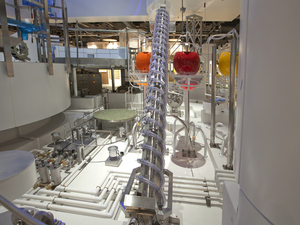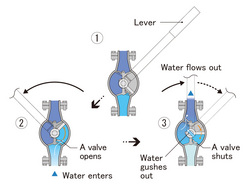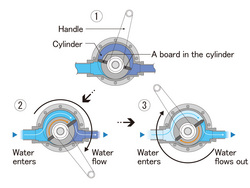Nagoya City Science Museum
TOP > Exhibition Guide > Keyword Search > Starting with "P" > pump > Archimedes' Pump / Wing Pump / Vane Pump
Archimedes' Pump / Wing Pump / Vane Pump

Purpose of Exhibition
Water on the ground evaporates and turns into vapor. It soars upwards and makes clouds in the sky. Over time clouds are transformed into rain (water), which returns to the ground and pours into the ocean. Water circulates on the earth. In this "Exploring Water" exhibition, you can deepen your knowledge about this big circulation and characteristics of water through various experiments.
We will explain two exhibits in this "Oceanic Stage". These experiments are for pumps that play an important role when we use water.


Additional Knowledge
[Archimedes' Pump]
It is easy to move water from a higher position to a lower position. If you want to make a canal, water will run into a lower place naturally. On the contrary, when transferring water from a lower position up to a higher position, we need to rely on a pump.
Archimedes was a scientist and engineer in Greece in third century B.C. Hieron, king of Syracuse where he was born, asked him for the design of a big ship "Syracusia" for sightseeing, transportation and naval fighting. Since Syracusia was huge, the water inundating and accumulating on the ship needed to be eliminated. As a result, he invented a pump with a spiral board in a cylinder. This is called Archimedes' pump. If rotated, this pump draws up water in a lower position, and can bring up water. It was invented as a pump during a time without electricity.
[Wing Pump]
This is a modern pump. However, it is not a pump that runs on electricity, but is hand operated. Water is drawn up by reciprocating a lever from right to left.
Suppose that the lever is on the right side now. When the lever is pulled to the left, a valve opens, and water enters the right cylinder inside the pump. Next, when the lever is pulled to the right, trapped water in the right cylinder is pushed out. Then, an open valve is shut, water flows through a hole at the lever axis and transfers to the left cylinder. Finally, it opens a valve above and gushes out (Figure1).
[Vane Pump]
This is also a modern pump which is hand operated. The center of the pump container and the center of the rotating lever are attached in a different position. When the lever is rotated, vanes work and push out the trapped water in the pump (Figure 2). This vane pump is suitable for when liquid needs to be transferred without mixing.
Article and by Koichi Mabuchi
